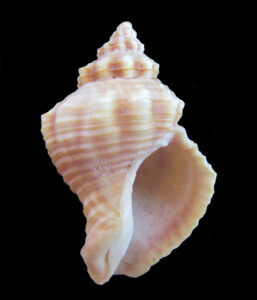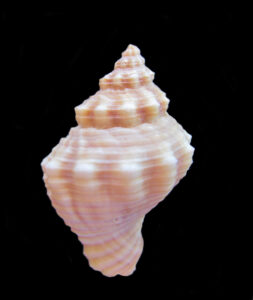Large-coiled Whelk Shell, Solenosteira macrospira

 Large-coiled Whelk Shell, Solenosteira macrospira. Shell collected off the beach of Bahía Concepción, Baja California Sur, October 2019. Size: 5.6 cm (2.2 inches) x 3.7 cm (1.4 inches). Collection, photograph and identification courtesy of Bob Hillis, Ivins, Utah.
Large-coiled Whelk Shell, Solenosteira macrospira. Shell collected off the beach of Bahía Concepción, Baja California Sur, October 2019. Size: 5.6 cm (2.2 inches) x 3.7 cm (1.4 inches). Collection, photograph and identification courtesy of Bob Hillis, Ivins, Utah.
Phylogeny: The Large-coiled Whelk, Solenosteira macrospira (Berry, 1957), is a gastropod mollusk that is a member of the Pisaniidae Family of False Triton Shells. The genus Solenosteira is one of twenty genera in this family, and there are eight species in this genus. Historically this species has been placed in the Buccinidae Family and has been recently reclassified into the Pisaniidae Family.
Description: Large-coiled Whelk shells are stout, with a large body whorl, and a moderately high spire. The shell is decorated with numerous, fine, spiral, ridges and many, heavy, length-wise, ribs. They have a large aperture and a wide siphon canal. The outer lip of the aperture is marked with fine teeth. The exterior of the shell is white in color, with tan to brown blotching; the interior is white. Large-coiled Whelk Shells reach a maximum of 6.6 cm (2.6 inches) in length and 4.4 cm (1.7 inches) in height.
Habitat and Distribution: Large-coiled Whelks live near rocks, in sandy or muddy substrates from the intertidal zone to depths up to 5 m (15 feet). They have a limited range in Mexican waters of the Pacific Ocean being only found throughout the Sea of Cortez which they are considered to ben endemic. They are absent from from the west coast of the Baja Peninsula or further south along the coasts mainland Mexico.
Ecology and Behavior: Large-coiled Whelks are scavengers that feed primarily on dead fish and invertebrates. They are gonochoric and reproduce sexually, with internal fertilization. The females mate with as many as twelve different males. She then lays her eggs on a male, who will carry the eggs for about one month. On average, only one-quarter of the eggs will be his offspring’s – the rest belong to other males. As the eggs develop, they become cannibals and feed on their siblings with the host male unable to stop this behavior. Reproduction occurs between February and May. There is no mention in the available literature of them engaging in any types of parasitic, commensal, or symbiotic relationships. From a conservation perspective they are considered to be Data Deficient.
Synonyms: Hanetia macrospira.